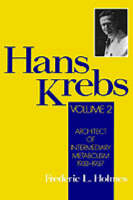
Hans Krebs
Architect of Intermediary Metabolism 1933-1937 (Volume II)
Seiten
1994
Oxford University Press Inc (Verlag)
978-0-19-507657-8 (ISBN)
Oxford University Press Inc (Verlag)
978-0-19-507657-8 (ISBN)
This second and final volume of the biography of Hans Krebs covers his early years in England, 1933-1937, when he laid the foundations of our modern understanding of intermediary metabolism.
This comprehensive volume completes Frederic Holmes's notable and detailed biography of Hans Krebs, from the investigator's early development through the major phase of his groundbreaking investigation, which lay the foundations upon which the modern structure of intermediary metabolism is built. With access to Krebs's research notebooks as well as to Krebs himself through more than five years of personal interviews, the author provides an insightful analysis of Hans Krebs and of the scientific process as a whole. The first volume, published in 1991, covered Krebs's formative years in Germany, his work with Otto Warburg, and his discovery of the urea cycle in 1932. This second volume reconstructs the investigative pathway and the professional and personal life of Hans Krebs, from the time of his arrival in England in 1933 until 1937, when he made the discovery for which he is best known--the formulation of the citric acid cycle. Holmes portrays Krebs's activity at the intimate level of daily interactions of thought and action, from which the characteristic patterns of scientific creativity can best be seen. Holmes's fascinating portrait of Krebs integrates the great scientist's investigative pathways with his personal life. The result is an illuminating analysis of both man and scientist that will be of interest to biochemists and historians of science.
This comprehensive volume completes Frederic Holmes's notable and detailed biography of Hans Krebs, from the investigator's early development through the major phase of his groundbreaking investigation, which lay the foundations upon which the modern structure of intermediary metabolism is built. With access to Krebs's research notebooks as well as to Krebs himself through more than five years of personal interviews, the author provides an insightful analysis of Hans Krebs and of the scientific process as a whole. The first volume, published in 1991, covered Krebs's formative years in Germany, his work with Otto Warburg, and his discovery of the urea cycle in 1932. This second volume reconstructs the investigative pathway and the professional and personal life of Hans Krebs, from the time of his arrival in England in 1933 until 1937, when he made the discovery for which he is best known--the formulation of the citric acid cycle. Holmes portrays Krebs's activity at the intimate level of daily interactions of thought and action, from which the characteristic patterns of scientific creativity can best be seen. Holmes's fascinating portrait of Krebs integrates the great scientist's investigative pathways with his personal life. The result is an illuminating analysis of both man and scientist that will be of interest to biochemists and historians of science.
Introduction ; 1. A new home for a career ; 2. Laboratory life in Cambridge ; 3. Progress under pressure ; 4. New moves ; 5. Arrivals and partings ; 6. The "Great Work" ; 7. Relocations and dismutations ; 8. Main routes and carriers ; 9. Full circle ; 10. Reflections ; Guide to structural formulas ; Notes
| Erscheint lt. Verlag | 3.2.1994 |
|---|---|
| Reihe/Serie | Monographs on the History and Philosophy of Biology |
| Zusatzinfo | halftones, line drawings |
| Verlagsort | New York |
| Sprache | englisch |
| Maße | 228 x 168 mm |
| Gewicht | 975 g |
| Themenwelt | Literatur ► Biografien / Erfahrungsberichte |
| Studium ► 1. Studienabschnitt (Vorklinik) ► Biochemie / Molekularbiologie | |
| Studium ► Querschnittsbereiche ► Geschichte / Ethik der Medizin | |
| Naturwissenschaften ► Biologie ► Biochemie | |
| ISBN-10 | 0-19-507657-5 / 0195076575 |
| ISBN-13 | 978-0-19-507657-8 / 9780195076578 |
| Zustand | Neuware |
| Haben Sie eine Frage zum Produkt? |
Mehr entdecken
aus dem Bereich
aus dem Bereich


